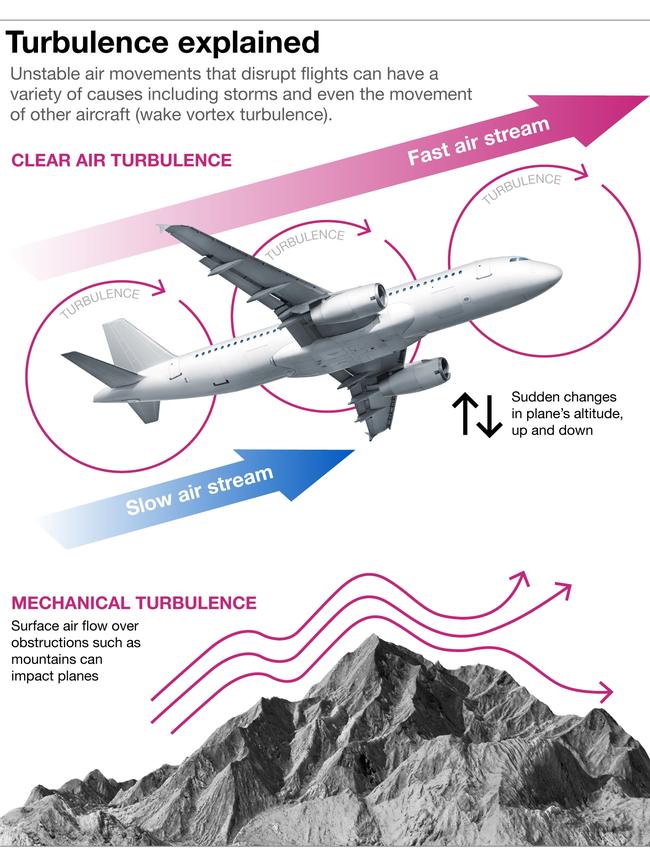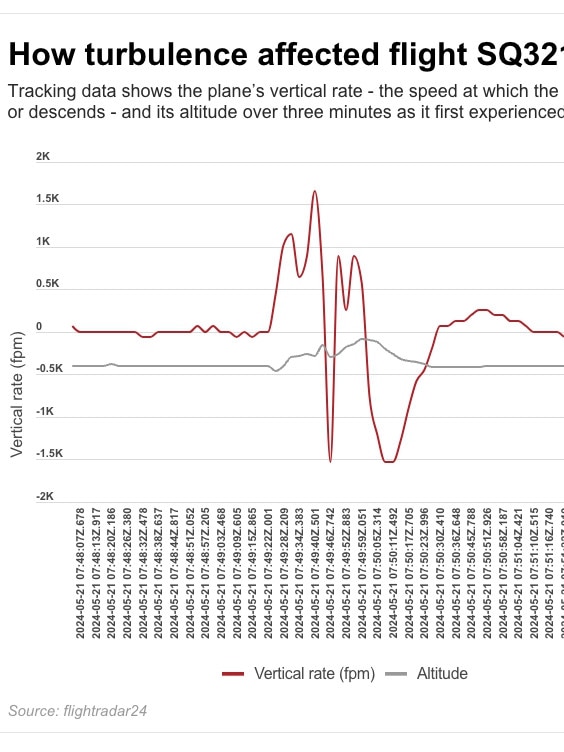Kerry Jordan, who was severely injured when Singapore Airlines flight 321 hit turbulence shares long road to recovery
A South Australian woman who was left paralysed from the chest down has spoken about her long road to recovery, as new evidence questions the flight path taken aboard Singapore Airlines SQ321.

SA News
Don't miss out on the headlines from SA News. Followed categories will be added to My News.
A South Australian woman who was left paralysed after severe turbulence aboard a horror Singapore Airlines flight is continuing to fight for adequate compensation.
South Australian couple Kerry Jordan and Keith Davis spoke out on 60 Minutes about the incident, which left 56 Australians injured and 13 hospitalised – while retired pilot Richard Woodward raised questions about whether the Singapore Airline flight could have avoided the dangerous thunderstorm altogether.
Ms Jordan said she had been trying to reattach her seatbelt after a trip to the bathroom when the turbulence hit with no warning.
The high-school dance teacher and performer became paralysed from the chest down, unlikely to ever walk again.

Her home in Adelaide’s south, which is built into the side of a hill, is now mostly inaccessible.
“The challenge of actually being able to get up ready for the day, it’s huge,” Ms Jordan told 60 Minutes.
“Life sometimes throws those challenges at you, and I just have to look at the positives.”
Ms Jordan said she now has to rely on “many people” to help her get ready “to face the day”.
“It’s not just the physical challenges, but the mental and emotional challenges with that, which takes its toll,” she said.
Aboard the flight, the couple said they remembered thinking that the aircraft “hit something” because the impact of the turbulence was “that violent.”
They have been offered $75,000 in compensation by the airline, but they are seeking better compensation – represented by former senator and lawyer Nick Xenophon.
Mr Woodward said flying through the weather system should have been avoided.
Satellite images and flight data obtained by 60 Minutes, reveals about an hour and 20 minutes before the turbulence struck, there was a build up of visible thunderstorms over central Myanmar.
“These are 10 minute snapshots but what they’re showing is the cells developing all-over southern Myanmar, so a big area of thunderstorm activity,” Mr Woodward told 60 Minutes.
“You should either be going through the coast, or swinging around.
“But you certainly wouldn’t try to fly down toward the thing because that’s where the weather is getting blown to.”
The new evidence – that forms part of the ongoing investigation – suggests there was human or mechanical failure aboard the flight that departed from London heading to Singapore on May 21.
Other data has revealed in the five minute period right before the incident occurred, the area was riddled with lightning strikes.
“Lightening only develops when the interaction in the storm between the ice particles and water, generate massive amounts of electricity
“More electricity in one spot than you get in a power station, so for lightning to be seen and be obvious on the radar picture, then there’s a fair amount of activity being developed.


Flight SQ321 was captured flying straight into the storm without a slight deviation to its course, leaving Mr Woodward to believe it was a “terrible miscalculation” to continue to the same trajectory with deviating.
“Thunderstorms climb very quickly and so they may be just a high cloud below you when you’re 10 minutes away, but they’re climbing several thousand feet a minute.
“They’re going to be at your altitude for eight or 10 minutes time.
“The crew would be seeing all these cells developing on the radar and waiting up whether they need to go around it or not.
“But it appears that they’re not deviating. They think they can get through this gap here.
Other planes that flew over the same area at the same time, were seen deviating to avoid the storm.
“They’re seeing the storms on their radar and they’re taking evasive action.”





